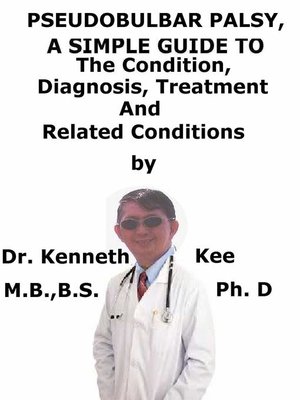Pseudobulbar Palsy, a Simple Guide to the Condition, Diagnosis, Treatment and Related Conditions
ebook
By Kenneth Kee

Sign up to save your library
With an OverDrive account, you can save your favorite libraries for at-a-glance information about availability. Find out more about OverDrive accounts.
Find this title in Libby, the library reading app by OverDrive.



Search for a digital library with this title
Title found at these libraries:
| Library Name | Distance |
|---|---|
| Loading... |
Pseudobulbar Palsy (PBP) is a medical disorder in which a person loses control of facial muscles and has trouble chewing or speakingThis can be caused by a range of neurological disorders.Patients with Pseudobulbar Palsy have:1. Difficulty chewing and swallowing;2. Spasticity in the tongue and bulbar regions.3. Slurred speech.They occasionally may also show uncontrolled emotional outbursts.CausesPseudobulbar Palsy (PBP) is normally produced by injury to neurons of brainstem, specifically the corticobulbar tract.Pseudobulbar palsy occurs from illness of the corticobulbar tracts.Bilateral tract injuries must occur for medically present disease as the muscles are bilaterally innervated.Pseudobulbar Palsy is produced as a result of some type of injury to motor fibers traveling from cerebral cortex to lower brainstem.This injury may be due to a range of neurological disorders affecting demyelination and bilateral corticobulbar disorders.Some of the disease factors which can produce Pseudobulbar Palsy are:1. Progressive supra-nuclear palsy2. Amyotrophic Lateral Sclerosis3. Parkinson's disease4. Motor neuron diseases5. Multiple sclerosis6. Brainstem tumors7. Neurological involvement in the case of Behcet's disease8. Injury to the braina. Cerebrovascular events - e.g., bilateral internal capsule infarcts.b. Demyelinating disorders - e.g., multiple sclerosis.c. Motor neuron disease.d. High brainstem tumors.e. Head injury.f. Neurosyphilis.In motor neuron disease it is frequent to see both bulbar and pseudobulbar palsies.Symptoms of Pseudobulbar Palsy are:1. Slurred speech2. Dysphagia (difficulty in swallowing)3. Tongue spasticity4. Brisk jaw jerk5. Dysarthria6. Labile affectSigns:1. Tongue - paralyzed; no wasting initially and no fasciculations; 'Donald Duck' speech; unable to protrude tongue.2. Palatal movements absent.3. Dribbling persistently.4. Facial muscles - may also be paralyzed.5. Reflexes - exaggerated (e.g., jaw jerk).6. Nasal regurgitation may be present.7. Dysphonia.8. Dysphagia.10. Emotional liability may also be present.There may also be neurological deficits in the limb - e.g., raised tone, improved reflexes and weakness.A confirmatory diagnosis of Pseudobulbar Palsy is dependent on the symptoms that a patient is havingThe MRI can also be done to look at the regions of anomalies in the brain.New developments in technology have led to the use of neurophysiological investigations to assess various aspects of speech dysfunctionA bulbar palsy is a lower motor neuron lesion of cranial nerves IX, X and XII.A pseudobulbar palsy is an upper motor neuron lesion of cranial nerves IX, X and XII.Since Pseudobulbar Palsy is produced as a result of some other underlying disease cause, hence treating the underlying cause normally treats Pseudobulbar Palsy.Medicines which can be used for Pseudobulbar Palsy are:1. Tricyclic antidepressants,2. SSRIs.There has been a new method to treat Pseudobulbar Palsy which uses dextromethorphan along with quinidine sulfate.All patients should be sent to neurologists for examinationTreatment will depend and directed to the underlying causePostural alterations can help with drooling of salivaThey may prevent aspiration.Supportive measures may have:1. Baclofen for spasticity,2. Anticholinergics for drooling,3. Treatment of aspiration pneumonia if it occurs and4. Attention to nutrition - e.g., enteral feedingTreatment should require:1. Speech therapists2. Language therapists and3. The dietician.Most causes of pseudobulbar palsy is from the brain such as stroke or a burst aneurym or brainstem tumor.Some need surgery.TABLE OF CONTENTIntroductionChapter 1 Pseudobulbar PalsyChapter 2 CausesChapter 3 SymptomsChapter 4 DiagnosisChapter 5 TreatmentChapter 6...







